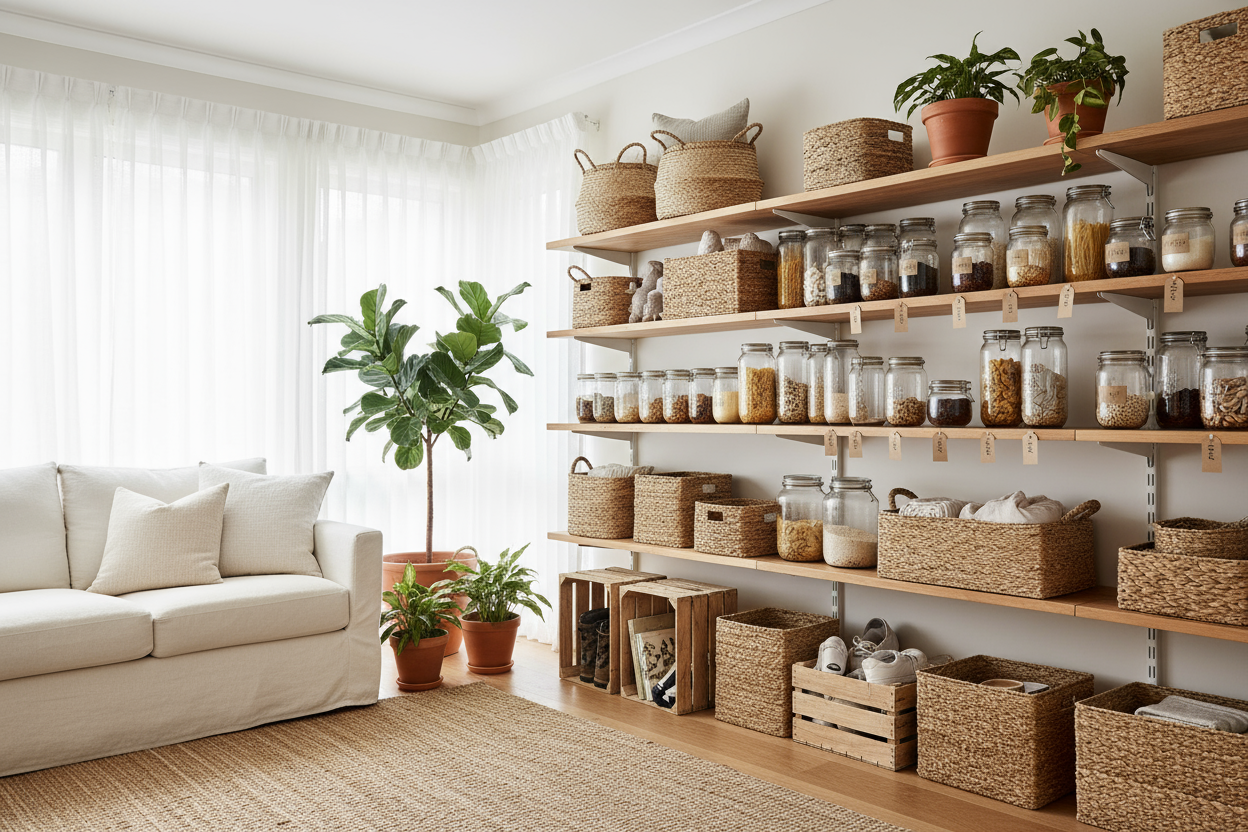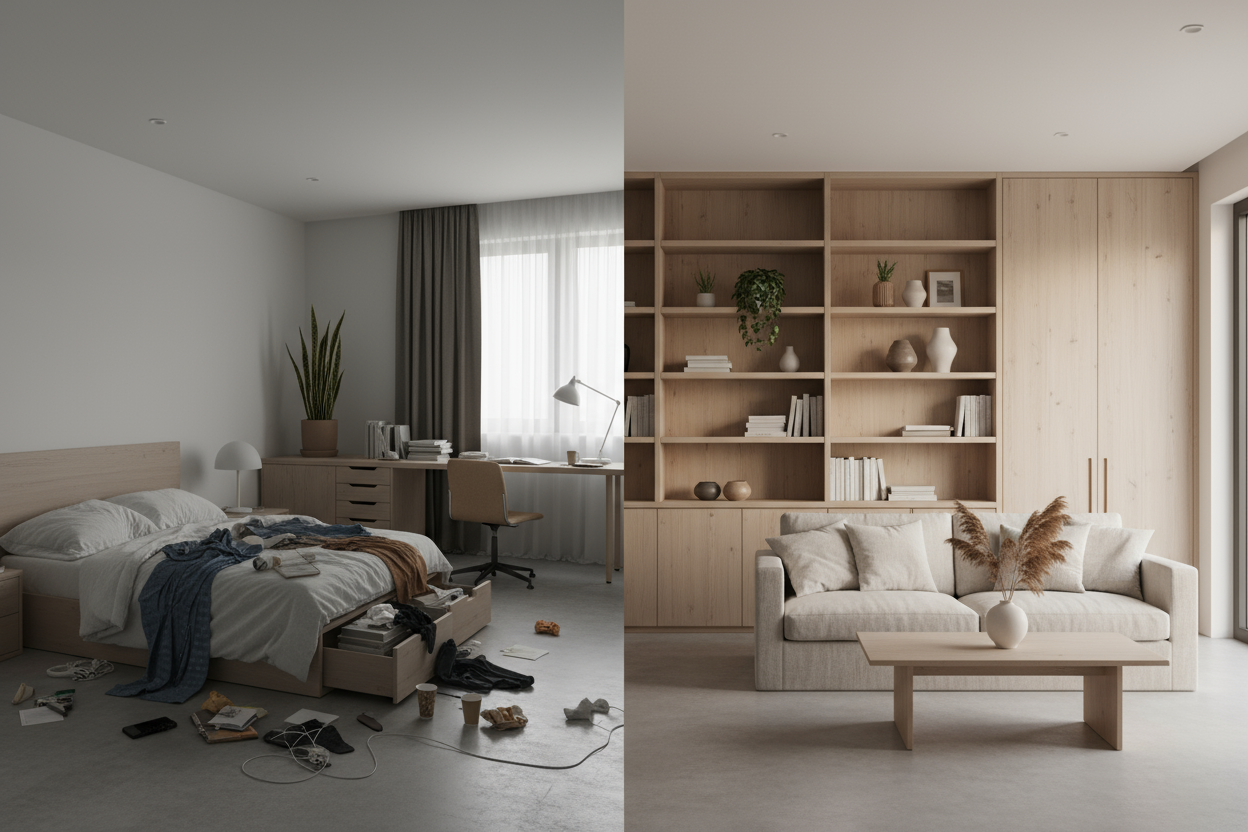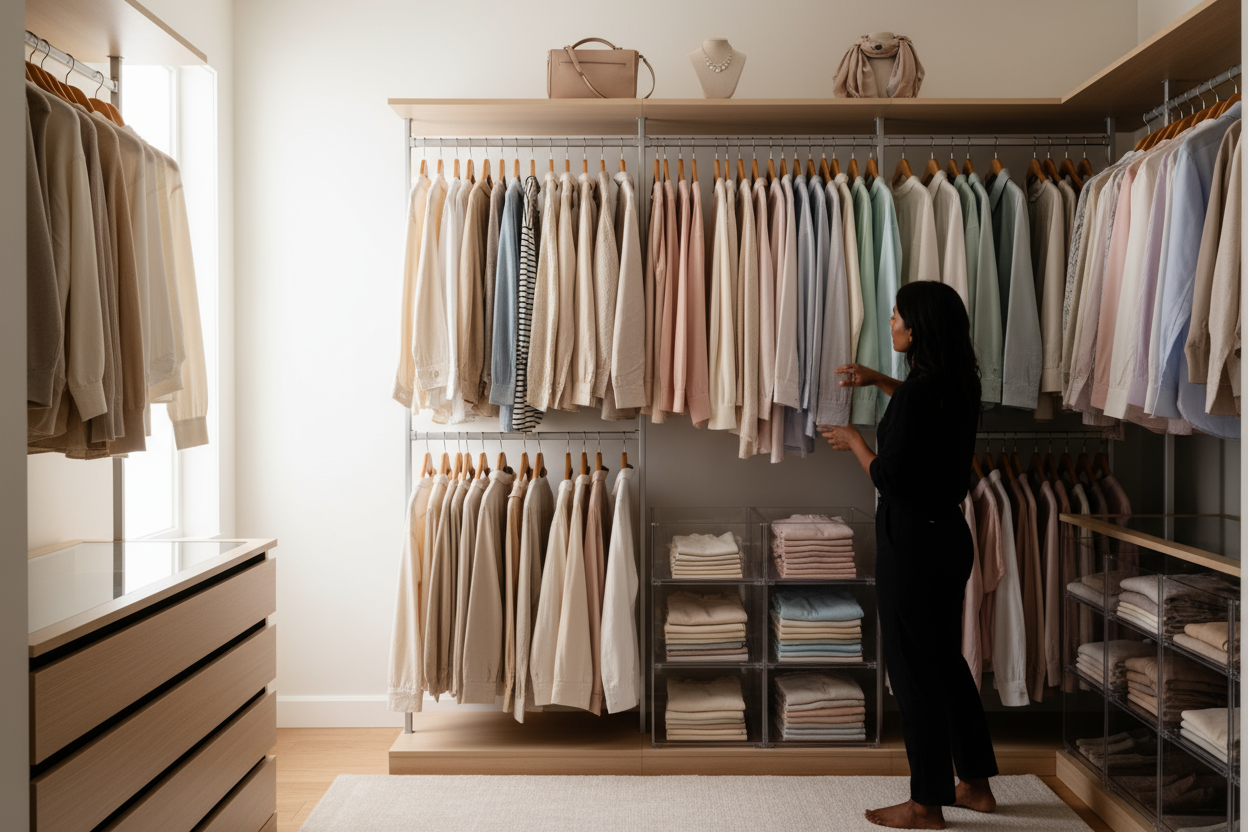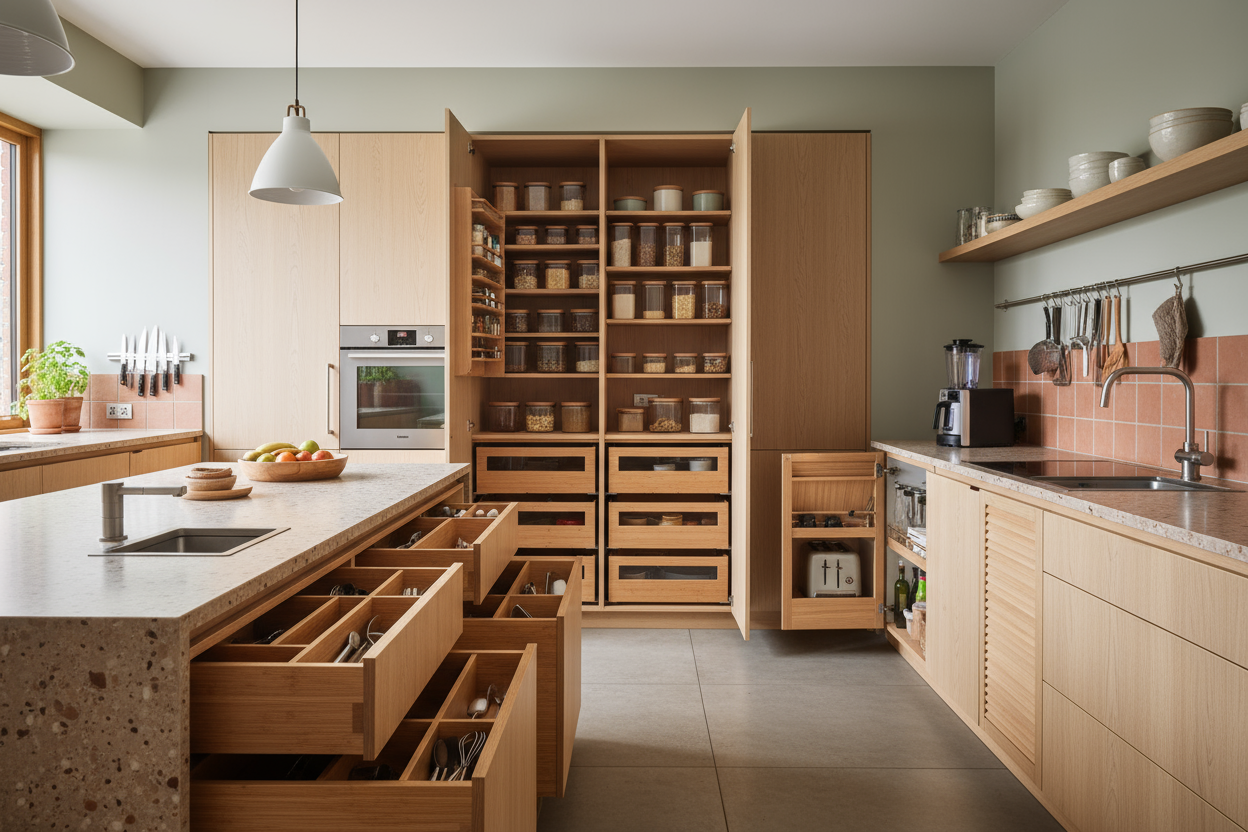Creating an organised home doesn't have to come at the expense of the environment. With growing awareness about sustainability, many Australians are seeking ways to reduce their environmental footprint while maintaining functional, beautiful living spaces. The challenge lies in finding sustainable storage solutions that actually work for real-world needs, from protecting belongings in humid conditions to maximising space in smaller homes.
The key to successful eco-conscious storage is balancing environmental responsibility with practical performance. This means understanding when to choose new sustainable materials, when to repurpose existing items, and when even environmentally minded homeowners might need to make pragmatic compromises for the long-term protection of their belongings.
Understanding Sustainable Storage Materials
When choosing eco-friendly storage options, the material makes all the difference. Natural fibres like bamboo, cotton, and woven grasses offer renewable alternatives to synthetic options, while recycled materials give new life to resources that might otherwise end up in landfill.
Bamboo containers and baskets stand out for their rapid growth rate and natural antimicrobial properties. Unlike hardwood alternatives that take decades to mature, bamboo reaches harvest readiness in just three to five years. Cotton storage boxes, particularly those made from organic cotton, provide breathable options that work well for clothing and textile storage.
For those seeking stylish solutions, artisanal woven baskets made from natural fibres combine functionality with aesthetic appeal. These handcrafted pieces often support traditional crafting communities while providing durable storage that improves with age rather than degrading like many synthetic alternatives.
Glass containers excel for pantry storage, offering complete visibility of contents while creating airtight seals that keep food fresh longer. Mason jars and repurposed glass containers can handle everything from bulk grains to craft supplies, and their transparency eliminates guesswork about what's stored inside.
Note: The properties of bamboo, including its fast growth and antimicrobial nature, should be confirmed by research (insert peer-reviewed citation).
The Reality of Moisture and Storage Challenges
While sustainable materials work beautifully in many situations, Australian homes often present unique challenges that require practical compromises. Humidity, whether from coastal locations, bathroom storage needs, or less-than-perfect ventilation, can quickly damage belongings stored in breathable natural materials.
For basement storage, laundries, or other damp-prone areas, plastic containers often provide the only reliable moisture barrier. The environmental impact of water damage and mould-ruined possessions frequently outweighs the footprint of using appropriate storage containers. When plastic becomes necessary, choosing second-hand bins offers an excellent compromise, providing needed protection while avoiding new plastic production.
Community observations consistently point to the effectiveness of adding moisture-absorbing materials inside storage containers. Silica gel packets, particularly rechargeable varieties, help control humidity levels inside bins and boxes. Activated charcoal pouches serve a dual purpose, absorbing excess moisture while neutralising odours that can develop in closed storage spaces.
Books and paper documents face particular vulnerability in humid conditions. Even the best storage containers may not prevent irreversible mould damage in consistently damp environments. For valuable books or documents, consider digitising important materials and storing physical copies in climate-controlled areas of the home rather than problematic basements or sheds.
These recommendations are based on common practice; validated effectiveness in specific conditions should be supported by further research (insert peer-reviewed citation).
Repurposing and Reusing Existing Items
The most sustainable storage solution often sits right in your current home. Repurposing existing containers, boxes, and household items reduces waste while saving money and storage space.
Shoe boxes make excellent drawer organisers, particularly when covered with contact paper or fabric for a finished appearance. Large glass jars from pasta sauce or pickles become perfect pantry containers for bulk items like rice, lentils, or baking supplies. Old suitcases can store seasonal items like holiday decorations or winter clothes, keeping them organised and dust-free.
Industrial containers offer another overlooked opportunity. Five-gallon buckets with tight-fitting lids, often available cheaply or free from construction sites or food service businesses, provide excellent moisture-proof storage for garage or shed organisation. These containers typically feature robust construction that outlasts purpose-made storage bins.
Wicker laundry baskets that have lost their shape for clothes can find new life as toy storage or general household organisation. Even damaged baskets often retain enough structure for lighter storage needs while maintaining their natural material benefits.
[collection-carousel="home-storage-baskets"]
The key to successful repurposing lies in matching container characteristics to storage needs. Consider factors like moisture resistance, stackability, and access frequency when assigning new roles to existing items.
Room-by-Room Sustainable Storage Strategies
Kitchen Storage Solutions
Kitchens benefit enormously from sustainable storage approaches that emphasise both function and food safety. Glass containers reign supreme for pantry organisation, offering airtight protection while eliminating chemical concerns associated with plastic food storage.
Bamboo drawer organisers provide natural antimicrobial benefits while keeping utensils and small tools organised. For larger items, consider repurposing attractive glass jars as canisters for bulk items like flour, sugar, and coffee beans. The transparency helps track inventory while the airtight seals maintain freshness.
Wire baskets, particularly those made from powder-coated steel, offer durability for produce storage while allowing air circulation. Unlike plastic alternatives, metal baskets won't absorb odours or stains from fruits and vegetables.
[collection-carousel="kitchen-storage-solutions"]
Wardrobe and Clothing Storage
Clothing storage presents excellent opportunities for sustainable practices, from cedar blocks that naturally repel insects to cotton garment bags that allow fabrics to breathe properly.
For seasonal clothing rotation, consider vacuum storage bags made from recycled materials. While not indefinite solutions, they maximise space efficiency and protect garments from moths and moisture during storage periods.
Wooden hangers, while requiring higher initial investment than plastic alternatives, often last decades and help maintain garment shape better than wire or plastic options. For those transitioning from plastic hangers, donate usable hangers rather than discarding them.
[collection-carousel="wardrobe-storage"]
Laundry Room Organisation
Laundry areas typically face high humidity and frequent use, making durability crucial for any storage solution. Natural fibre baskets work well for clean laundry sorting, while moisture-resistant options may be necessary for detergent and cleaning supply storage.
Repurposed glass jars excel for storing homemade cleaning solutions or bulk detergent, offering clear visibility of contents and quantities. For fabric softener alternatives, consider wool dryer balls stored in breathable cotton bags.
[collection-carousel="laundry-storage-solutions"]
Making Smart Compromises
Perfect sustainability isn't always practical or even truly sustainable when viewed long-term. Sometimes choosing a durable synthetic option that lasts decades creates less environmental impact than repeatedly replacing natural materials that degrade quickly in specific conditions.
When plastic becomes necessary, prioritise quality over quantity. A well-made plastic storage system that serves multiple functions for many years often proves more sustainable than multiple cheaper natural alternatives that require frequent replacement.
Consider the full lifecycle of storage purchases. A bamboo container that warps and splits within two years due to humidity exposure creates more waste than a quality plastic alternative that functions reliably for a decade or longer.
For areas with specific environmental challenges, hybrid approaches often work best. Use natural materials where they excel, like breathable cotton for clothing storage, while reserving synthetic options for moisture-prone areas or items requiring absolute protection.
Maintenance and Longevity Tips
Extending the life of any storage solution, regardless of material, represents the most sustainable approach. Regular maintenance prevents premature replacement and ensures continued functionality.
Natural fibre baskets benefit from occasional gentle cleaning with mild soap and thorough drying. Avoid soaking, which can weaken fibres and joints. For bamboo containers, periodic light oiling helps maintain flexibility and prevents cracking.
Glass storage containers need careful handling but reward users with decades of service when properly maintained. Avoid extreme temperature changes and check seals regularly for wear that might compromise airtight storage.
Even plastic containers deserve proper care to maximise their lifespan. Regular cleaning prevents odour absorption and staining, while careful handling prevents cracks that can lead to failure.
Monitor stored items regularly, particularly in areas prone to humidity changes. Early detection of moisture issues can prevent widespread damage and the need to replace both storage containers and their contents.
Building Your Sustainable Storage System
Creating an effective eco-friendly storage system requires thoughtful planning rather than impulse purchases. Start by auditing your current storage needs and existing containers that might be repurposed.
Prioritise high-use areas first, where quality storage solutions provide daily benefits. These investments often justify higher initial costs through extended use and improved functionality.
Consider modular systems that can adapt as needs change. Stackable containers, whether made from sustainable materials or quality recycled plastic, offer flexibility that prevents the need for complete system replacement when storage requirements evolve.
For items with specific requirements, like protecting important documents or storing seasonal decorations, invest in appropriate specialised storage rather than hoping general-purpose containers will suffice. Proper protection from the start prevents costly replacement of damaged items.
Don't feel pressured to replace all storage immediately. A gradual transition allows you to test different sustainable options and replace items as they wear out naturally, reducing waste from functional storage that gets discarded prematurely.
This article reflects practical knowledge and commonly observed strategies; it has not been reviewed by professional organisers or material scientists.
When to Seek Professional Advice
Some storage challenges benefit from professional consultation, particularly in homes with ongoing moisture issues or valuable items requiring specialised protection.
Building professionals can address underlying humidity problems that make any storage solution less effective. Resolving ventilation or waterproofing issues often proves more cost-effective than repeatedly replacing storage containers and their contents.
For valuable collections, archival specialists can recommend appropriate storage materials and techniques that balance preservation with environmental considerations.
How We Can Help
Finding the right balance between sustainability and functionality doesn't have to be overwhelming. Our curated collection of storage solutions emphasises durability, natural materials where appropriate, and smart design that maximises both space efficiency and environmental responsibility.
Whether you're organising a single room or implementing whole-home storage systems, we offer options that align with eco-conscious values while delivering the practical performance Australian homes demand.
[collection-carousel="home-storage"]
Moving Forward Sustainably
Sustainable storage isn't about perfection but about making thoughtful choices that balance environmental impact with practical needs. By understanding material properties, maintaining storage solutions properly, and making smart compromises when necessary, you can create an organised home that reflects your environmental values.
Remember that the most sustainable storage solution is often the one you already own and use effectively. Before purchasing new containers, explore repurposing opportunities and consider whether simple organisation changes might solve storage challenges without additional purchases.
The goal is creating systems that serve your household well for years to come, reducing the need for frequent replacements while keeping your belongings organised, protected, and easily accessible.





